
Broomcorn, or sorghum vulgare, is an annual that can grow to fifteen feet in a season. It is a crop grown primarily for the manufacture of brooms, and whisk brooms. It appears in the literature in the late 1500’s, in Italy; Benjamin Franklin is reputed to have introduced broomcorn to the US in 1700. Though I have been using broomcorn ornamentally in fall pots for years, the above mentioned facts I learned only yesterday. As I am focused on how plants look, I am impressed with that enterprising person that dried this plant, and made brooms. I will admit I did go and check out the broom in my office.
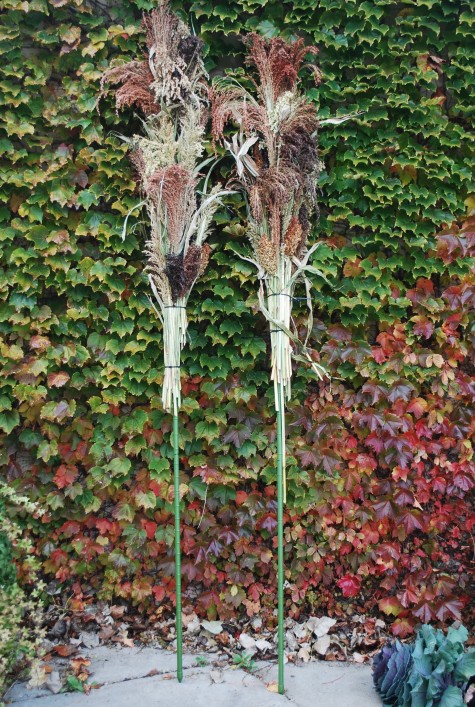
They make a swell centerpiece in a fall pot. For this six foot tall centerpiece, I loosely zip-tie two levels of material to a vinyl coated steel stake, and stuff my way down. The metal stake is a good idea-these stems are juicy, and very heavy. I like to use fresh cut sorghum and millet as they dry in whatever position you have them.
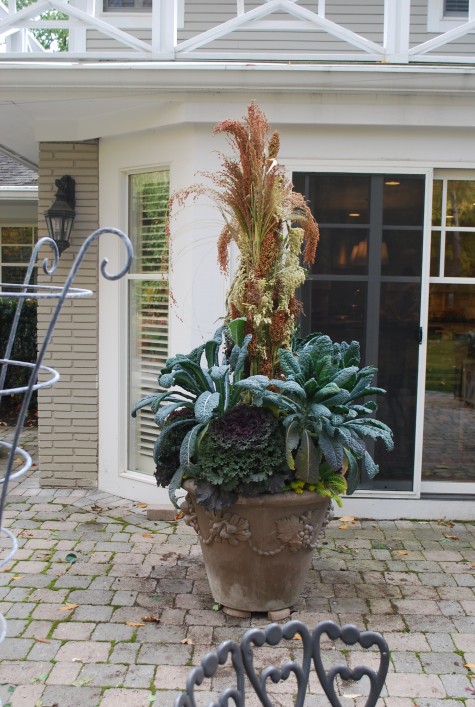 The metal stake is inserted as close to the bottom of the pot as possible. A listing, out of vertical centerpiece-on my top ten list of things I really dislike. The long fibrous panicle of the broomcorn plant arches over gracefully in a pot. I repeat that graceful arching with some leggy Tuscan blue kale; this combination is a good foil for those utterly organized cabbages.
The metal stake is inserted as close to the bottom of the pot as possible. A listing, out of vertical centerpiece-on my top ten list of things I really dislike. The long fibrous panicle of the broomcorn plant arches over gracefully in a pot. I repeat that graceful arching with some leggy Tuscan blue kale; this combination is a good foil for those utterly organized cabbages.
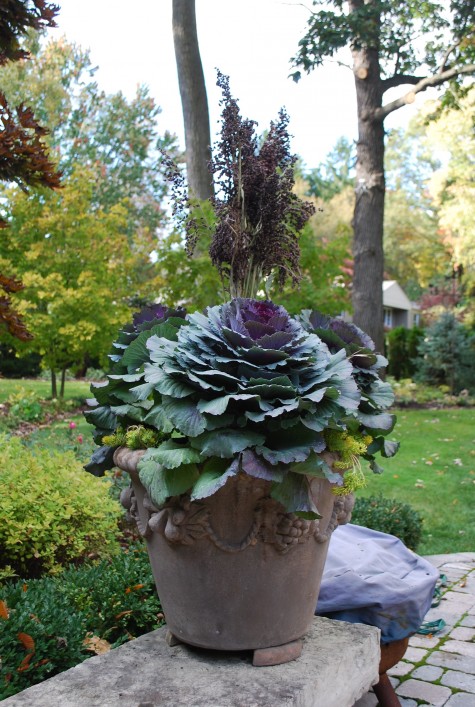 Sometimes I sort the broomcorn bunches for color. The dark stems are a beautiful compliment to this Francesco Del Re pot; plugs of angelina sedum infill the gaps. As I discussed yesterday, elevating the pots allows water to drain away freely. We will need this when dressing the pots for the winter.
Sometimes I sort the broomcorn bunches for color. The dark stems are a beautiful compliment to this Francesco Del Re pot; plugs of angelina sedum infill the gaps. As I discussed yesterday, elevating the pots allows water to drain away freely. We will need this when dressing the pots for the winter.
 The green-cream and peach sorghum contrasts well with its counterpart in a dark purple-brown. I do not know if any of these stems would pass muster for broom-making material, but they make for a great fall pot. That blue kale foliage is an unusual color in Michigan landscapes; it stands out.
The green-cream and peach sorghum contrasts well with its counterpart in a dark purple-brown. I do not know if any of these stems would pass muster for broom-making material, but they make for a great fall pot. That blue kale foliage is an unusual color in Michigan landscapes; it stands out.
 Ornamental cabbages only get better as the night temperatures drop; they color up. They are best planted as a tutu. Plants with a stiff aspect need some friendly and loose companionship. Thus this combination. The lime green angelina will take on an orange cast in cold weather, as in 37 degrees when I came to work this morning.
Ornamental cabbages only get better as the night temperatures drop; they color up. They are best planted as a tutu. Plants with a stiff aspect need some friendly and loose companionship. Thus this combination. The lime green angelina will take on an orange cast in cold weather, as in 37 degrees when I came to work this morning.
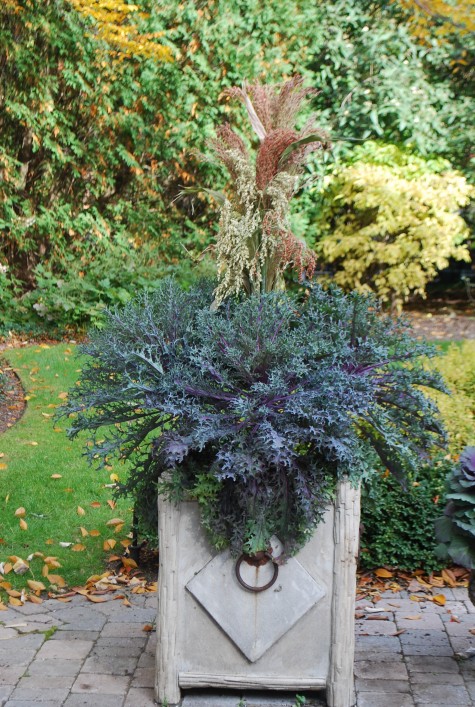 This lace leaf kale is all about air, at the same time that it defines an overall shape. What more could any gardener ask of a plant? As kales and cabbages shed their lower leaves, I may bury the trunk as needed in the soil, and pitch the head forward some. The entire arrangement-saucy enough to attract attention.
This lace leaf kale is all about air, at the same time that it defines an overall shape. What more could any gardener ask of a plant? As kales and cabbages shed their lower leaves, I may bury the trunk as needed in the soil, and pitch the head forward some. The entire arrangement-saucy enough to attract attention.
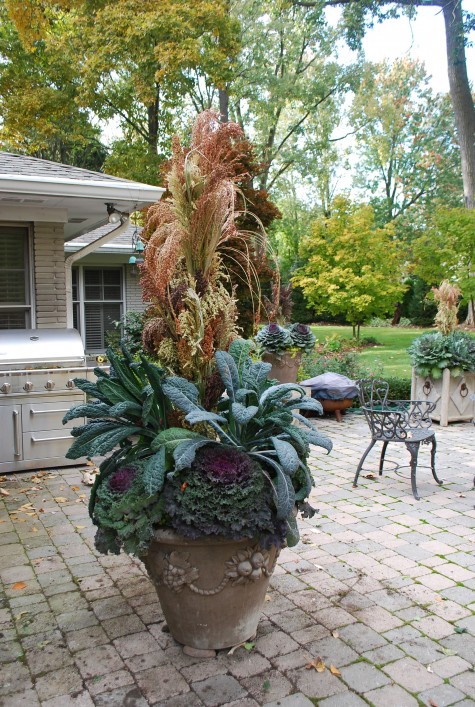
I plant my clients pots four times a year; her pair of concrete squares, and three Francesco Del Re pots get dressed up for each season. Every season she is looking out her kitchen window expecting to see something beautiful. I suppose if I made a big issue of the history and ornamental use of broomcorn, she would listen. But her attention to that horticulture would not be the point. As I try to provide her with a view to something, I am interested in any plant, including a big rangy annual usually grown as a crop, that delivers.
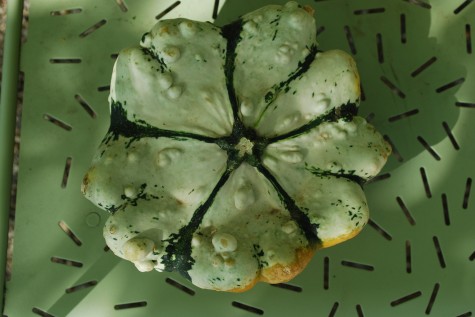
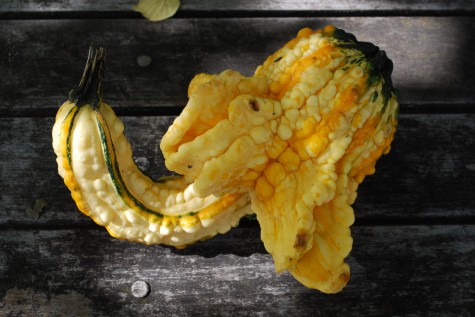
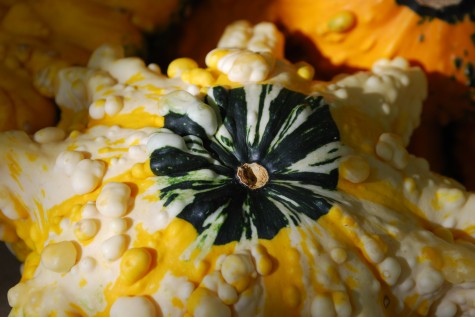
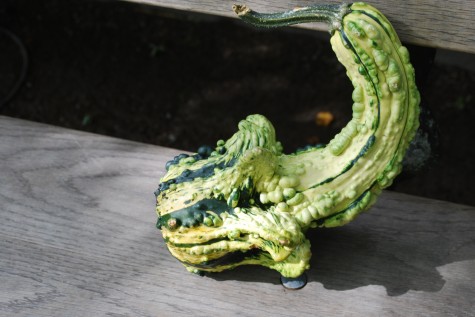
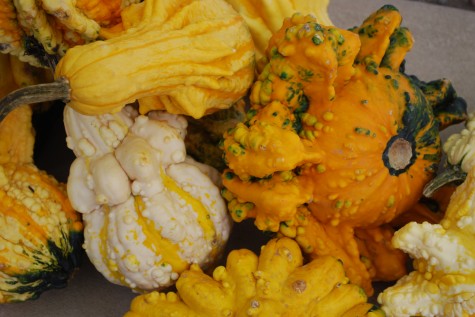
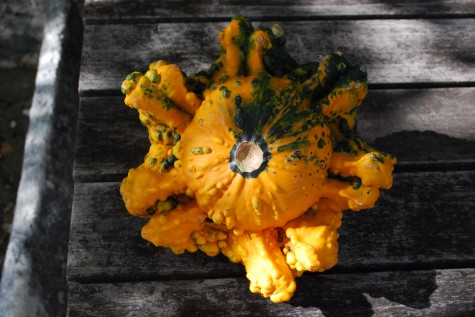


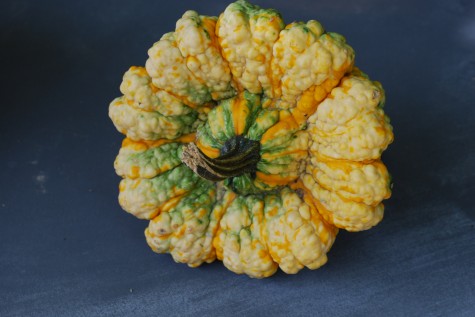
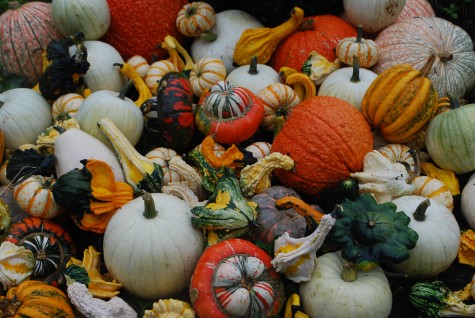
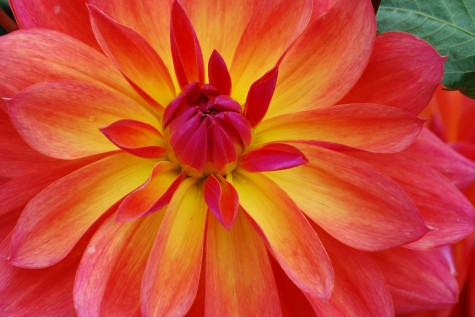 The cultivation of dahlias brings to mind the famed Longfellow little girl verse. “When she was good/She was very very good/But when she was bad she was horrid”. Even if you give them everything you’ve got in the way of rich soil, good sun, staking, fertilization, good air circulation and your utmost devotion, it may not be enough. You still need the blessing of the patron saint of all sulky, troublesome prima donna garden flowers-whomever she may be. Not that one could ask for that blessing; it must be bestowed. I do have one client for whom they perform on demand. He says its the soil-I say what he manages with them is magic.
The cultivation of dahlias brings to mind the famed Longfellow little girl verse. “When she was good/She was very very good/But when she was bad she was horrid”. Even if you give them everything you’ve got in the way of rich soil, good sun, staking, fertilization, good air circulation and your utmost devotion, it may not be enough. You still need the blessing of the patron saint of all sulky, troublesome prima donna garden flowers-whomever she may be. Not that one could ask for that blessing; it must be bestowed. I do have one client for whom they perform on demand. He says its the soil-I say what he manages with them is magic. 
 Some sport blooms so large the word vulgar comes to mind. Some “dinnerplate dahlias” have stems so weak the plant perpetually looks like someone spent the last hour giving them a thorough dressing down. Fungus spreads like crazy from the bottom up; I have grown plenty of dahlia stalks with a few anemic and forlorn flowers on top. When I grow them in pots, I face them down with something that has the decency to grow vigorously, and hide those ungainly dahlia legs.
Some sport blooms so large the word vulgar comes to mind. Some “dinnerplate dahlias” have stems so weak the plant perpetually looks like someone spent the last hour giving them a thorough dressing down. Fungus spreads like crazy from the bottom up; I have grown plenty of dahlia stalks with a few anemic and forlorn flowers on top. When I grow them in pots, I face them down with something that has the decency to grow vigorously, and hide those ungainly dahlia legs.  So why do I grow them? In a good year, they are magnificent. Loaded with flowers, they remind me of the 19th century flower paintings of Rachel Ruysch; they are supremely grand. The range of colors and forms is astonishing. This dahlia is a “formal decorative” type. Park Princess has petals shaped like quills; this form is known as a “cactus dahlia”.
So why do I grow them? In a good year, they are magnificent. Loaded with flowers, they remind me of the 19th century flower paintings of Rachel Ruysch; they are supremely grand. The range of colors and forms is astonishing. This dahlia is a “formal decorative” type. Park Princess has petals shaped like quills; this form is known as a “cactus dahlia”. 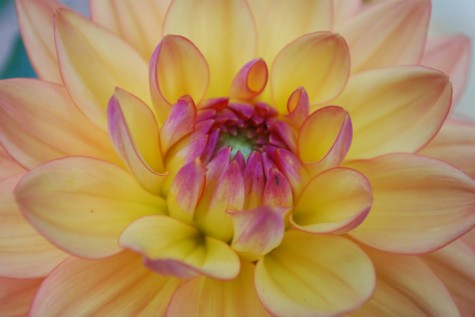
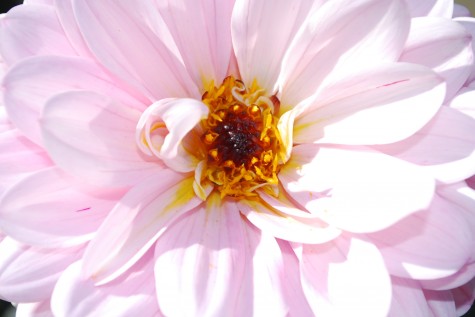 I am looking at these dahlias now as they have been at their peak this first week of October. There is something to recommend about how they last into the fall. They do hate cold weather; the best grown dahlias are those that have spent May and June in a greenhouse. They transition from that museum like setting to the Michigan outdoors poorly. It can take weeks before they loose that insulted look, and take hold.
I am looking at these dahlias now as they have been at their peak this first week of October. There is something to recommend about how they last into the fall. They do hate cold weather; the best grown dahlias are those that have spent May and June in a greenhouse. They transition from that museum like setting to the Michigan outdoors poorly. It can take weeks before they loose that insulted look, and take hold.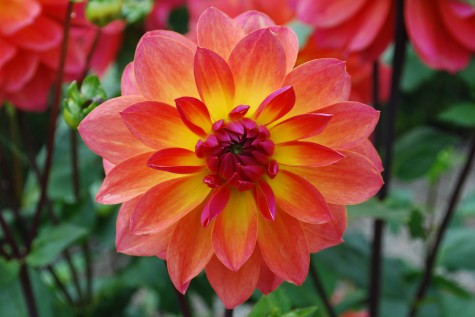 I think a too early planting can set them back such that they never recover. They thrive in that rarefied hothouse atmosphere where wind, bugs, cold soil, and various pathogens are simply not permitted. Dahlias are not great garden plants; they are an event you may wish to attend.
I think a too early planting can set them back such that they never recover. They thrive in that rarefied hothouse atmosphere where wind, bugs, cold soil, and various pathogens are simply not permitted. Dahlias are not great garden plants; they are an event you may wish to attend.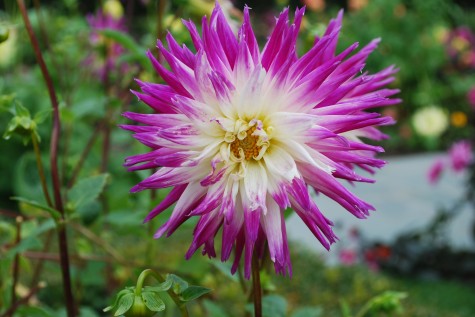 Some of these party girls dress in a way that’s just plain fun to look at. When they are at their overblown best, they make me smile.
Some of these party girls dress in a way that’s just plain fun to look at. When they are at their overblown best, they make me smile.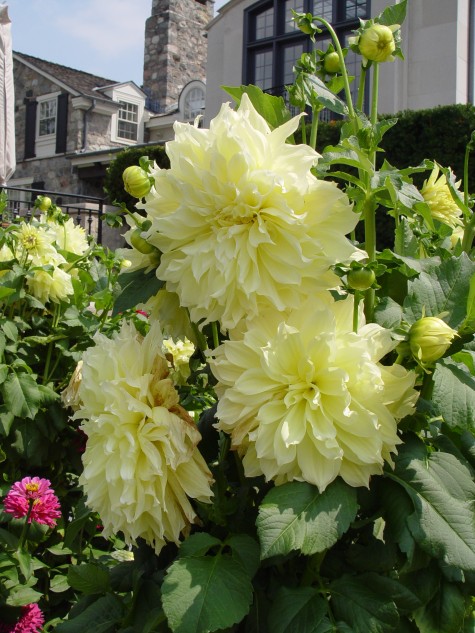
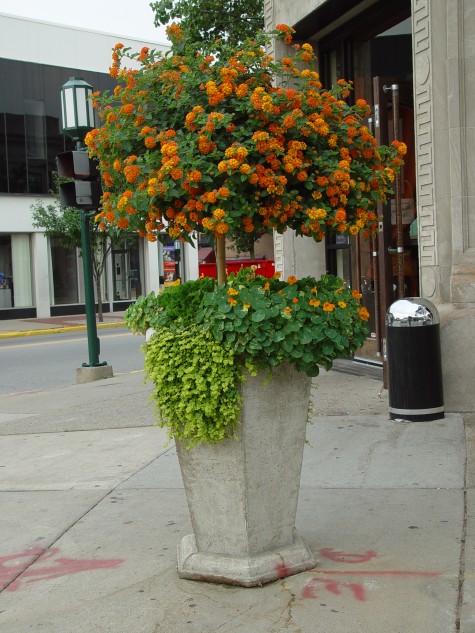 Topiary is the art of pruning, and training a plant to grow in whatever shape you might fancy. Plenty of plant species lend themselves to this kind of treatment. The above pictured lantana is seven years old. It began as a small plant, whose side branches were removed until the primary trunk was about four feet tall. A devoted grower then pinched back the main leader-the first step in the formation of the top. As I like slightly flattened spherical shapes in topiary, we keep the top pruned, and grow the side shoots wide. Lantana flowers profusely in hot weather, it makes a strikingly statuesque topiary plant. In the fall, I cut the head of the plant back by two-thirds,, strip all the remaining leaves off, and stash it in the greenhouse. I strip the leaves off, as lantana is a magnet for whitefly-and they multiply like lightening in a green house environment. What they require is plenty of trouble, but it is glorious in form and flower.
Topiary is the art of pruning, and training a plant to grow in whatever shape you might fancy. Plenty of plant species lend themselves to this kind of treatment. The above pictured lantana is seven years old. It began as a small plant, whose side branches were removed until the primary trunk was about four feet tall. A devoted grower then pinched back the main leader-the first step in the formation of the top. As I like slightly flattened spherical shapes in topiary, we keep the top pruned, and grow the side shoots wide. Lantana flowers profusely in hot weather, it makes a strikingly statuesque topiary plant. In the fall, I cut the head of the plant back by two-thirds,, strip all the remaining leaves off, and stash it in the greenhouse. I strip the leaves off, as lantana is a magnet for whitefly-and they multiply like lightening in a green house environment. What they require is plenty of trouble, but it is glorious in form and flower. 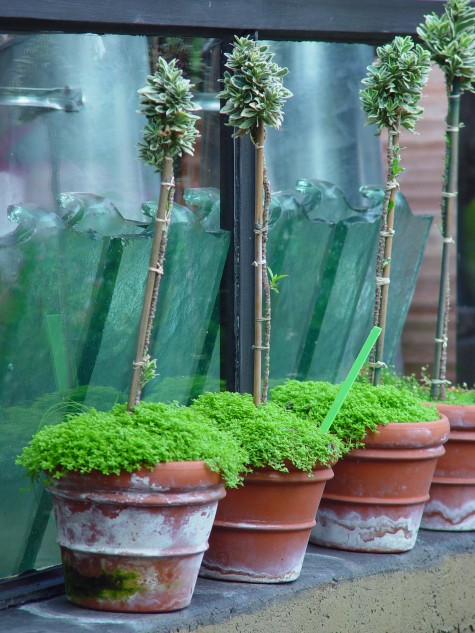 Well grown large topiary plants are expensive. It takes a lot of time to grow them on-sometimes years go by before a plant can be sold. This dwarf variegated euonymus with a batch of leaves atop a stem tells the story. In ten years, this plant will not be much taller-just much stockier, with a full head of leafy branches. As euonymus is a hardy shrub, they like to be wintered in a cool light place.
Well grown large topiary plants are expensive. It takes a lot of time to grow them on-sometimes years go by before a plant can be sold. This dwarf variegated euonymus with a batch of leaves atop a stem tells the story. In ten years, this plant will not be much taller-just much stockier, with a full head of leafy branches. As euonymus is a hardy shrub, they like to be wintered in a cool light place. 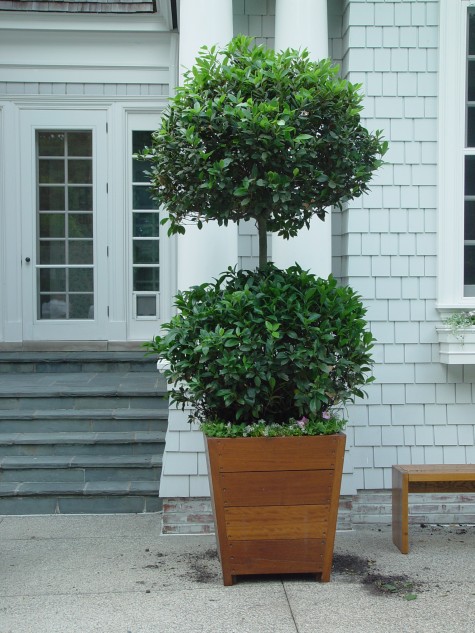 Bay Laurel is not hardy here, unfortunately-so a greenhouse is a necessity in the winter. This plant is 14 years old. This single ball topiary suckered at the base so persistently, I finally just let it grow. The formal shape is easy to keep up; you can see it needs a little haircut right now. There are many kinds of topiary shears available-I like short bladed snips, so I can cut branches without slicing into the leaves. Any leaf that is cut will show that telltale browing on that cut edge within days. �
Bay Laurel is not hardy here, unfortunately-so a greenhouse is a necessity in the winter. This plant is 14 years old. This single ball topiary suckered at the base so persistently, I finally just let it grow. The formal shape is easy to keep up; you can see it needs a little haircut right now. There are many kinds of topiary shears available-I like short bladed snips, so I can cut branches without slicing into the leaves. Any leaf that is cut will show that telltale browing on that cut edge within days. �
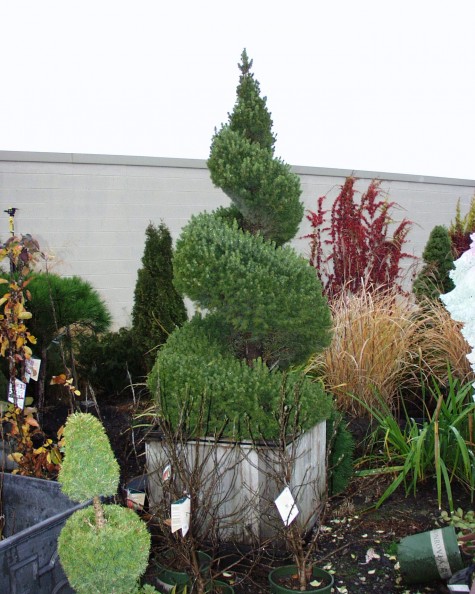

 Ivy can be readily be trained over a wire form. This makes it an ideal subject for fast growing. The vines are tied to the form to provide completely coverage, and the vines are clipped as needed. Hedera algeriensis ” Gloire de Marengo”, or variegated Algerian ivy, has large glossy leaves, and a prominent white variegation; old topiaries grown from this plant are striking. A bonus-it is possible to winter ivy topiaries over in the house.
Ivy can be readily be trained over a wire form. This makes it an ideal subject for fast growing. The vines are tied to the form to provide completely coverage, and the vines are clipped as needed. Hedera algeriensis ” Gloire de Marengo”, or variegated Algerian ivy, has large glossy leaves, and a prominent white variegation; old topiaries grown from this plant are striking. A bonus-it is possible to winter ivy topiaries over in the house.  The coleus topiary I let go after two seasons-they seem to loose vigor. The minute you decide to grow a plant in any form which is not its natural form, there will be maintenance problems down the road. Plants tolerate being fooled with by people-they rarely love it. Plants that naturally lend themselves to this treatment are easier to look after.
The coleus topiary I let go after two seasons-they seem to loose vigor. The minute you decide to grow a plant in any form which is not its natural form, there will be maintenance problems down the road. Plants tolerate being fooled with by people-they rarely love it. Plants that naturally lend themselves to this treatment are easier to look after.